|
1 | 2 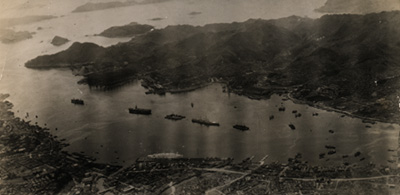 Click image to enlarge The only places seen carrying on normal operations were the post office, and a tire shop. Several offices of various types are open but little activity goes on. Small overcrowded ferries cross the harbor taking people to work making plows at a former war factory. Early Thursday morning, September 13th, eight amphibious landing craft left the anchorage on a mission completely different from that for which they were originally designed. Instead of being loaded with armed marines or soldiers ready to storm ashore, there were almost empty. The leading craft did have a 20 mm. machine gun manned, just in case, but the little flat-bottomed, snub-nosed boats, other than the first one which carried several officers in charge, were empty save for their regular three men crews. Their destination was the first POW camp to be evacuated, on Koyaki Island, three miles south. When they reached there, the ex-prisoners had been already given indentification tags by an Army rescue team and were ready to leave the place where they had been incarcerated for nearly three years. A total of 492, only two of whom were stretcher cases, were taken off the island. Most of them were British, Dutch and Japanese who had been captured when Java fell in 1942. The camp buildings were fairly decent, although small dog-house like structures, where a person could neither stretch out while lying down or stand up erectly, were used for solitary confinement. A total of 72 deaths had occurred here over a period of three years. The maximum population was 1500. Men here had worked at a nearby shipyard, and their diet had been approximately that of the natives. Several large piles of colored parachutes were noticed. These were why the men had gained on an average of 15 pounds in the last month, having been dropped by B-29s, or flying grocers, as they are affectionately called by the evacuees. On
the trip back to the anchorage, the men pressed on their rescuers gum
and cigarettes, claiming they had more than they could carry. Many of
them thought they should save the rations they couldn't eat and it took
considerable persuasion to get them to believe there was more and better
food awaiting them. Much of the material they carried was good breeding
ground for insects. One Scotchman, however, hung on to six cartons of
American cigarettes. They told how the Japs had experienced much difficulty
actually completing any ships due to lack of knowledge in launching
and because of sly sabotage on the part of the ex-POWs. One Englishman
was anxious to learn when the SARATOGA had been sunk. "We heard it had
gone down several times," he said. When told the dowager queen of the
flat-tops was still afloat, he replied, "Well, we didn't really believe
it, but it was told to us so blooming often." 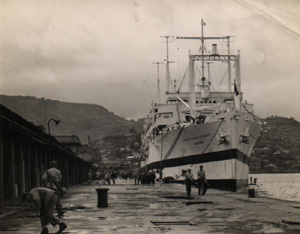 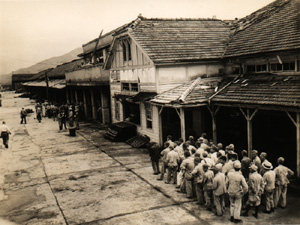 Click images to enlarge Back at the harbor, the men were speedily sent through a continuous production line processing, questioned, examined physically, cleaned, given new Navy clothing, and perhaps most welcome of all, doughnuts and good coffee, ice cream, chocolate malted milk and sandwiches by the Navy. They also received Red Cross kits, and as one limey dug into his he pulled out a pipe, exclaiming, "Blimey, a proper pipe at last." At
the end of the first day's processing, 683 persons, including 5 Americans
and 16 women had been given attention. The first man to be assigned
to the CHENAGO was a Brooklyn born Irishman who had gone to the ould
[sic] sod when 6 years old. Several of the first day's group were survivors
of the British cruiser EXETER, sunk Feb. 28, 1942, when the US destroyer
POPE went down. Three US Navy officers from the POPE were at the Koyaki
camp until about three months ago, when they were transferred. "The
guards made special attempts to make the Americans look ridiculous before
us," one evacuee reported. 
A group of seven British merchant seamen did not wait for a formal rescue but hitched a ride on a train from a camp north of here. The survivors of the tanker PETALLA and the freighter JEMSTONE, sunk in the South Atlantic by two armed German raiders in April 1942, they were taken aboard one of the raiders, the MICHAEL. Also sunk were five other ships, including the American ships CONNECTICUT and STANVAC CALCUTTA. A total of 200 survivors were picked up by the MICHAEL which was equipped with underwater torpedo tubes, a seaplane bearing American markings and a motor torpedo boat. Their trip to Japan was by way of the South Atlantic around the cape through the Antarctic up to Java, thence to Yokohama, being transferred to a German tanker and a German cargo ship en route. This took nine weeks. When they arrived in the Jap harbor there were nine other German ships there. In their camp, they were awakened every morning by a slap in the face with the butt of a rifle. The second day's group was brought here by train from camps north of the city and were greeted by a 10 piece Navy band playing "Hail, Hail the Gang's All Here", and "California, Here I Come". Visibly affected by the music, the men also showed the strain of their imprisonment and torture much more clearly than the first day's group. Included in this group were survivors of the Bataan death march, Wake Island, and the sinking of the USS HOUSTON. When they finished the processing, they were given Army clothes and durable Army shoes and boots. Many of them arrived wearing the Japanese glove like slipper with a space between the big and second toe. A few had saved complete, or almost so, of their old uniforms and proud was a Dutch sailor who had a spotless white uniform. The hell through which all of the evacuees have gone was even more evident in the third day's group. Fifty-two stretcher cases, many of them living skeletons, others with one or both legs gone, were the first to be taken from the train which arrived two hours late at 1400. Most of them were British, Dutch, and Javanese with a few Americans. Among the latter were two doctors in the US Army and part of a medical detachment captured in the Phillippines. They had been kept there until late in 1943 when they were brought to Kyushu. Most of the other nationals had been part of a large group sent to Thailand to work on a railroad where some 30,000 died from diseases. After leaving Thailand, they were in a convoy attacked by American planes and several were survivors of the resultant sinkings. These men had worked in coal and zinc mines and had suffered brutally at the hands of their prison commander, whose favorite punishment was to make the men kneel in snow and then have water poured over their naked bodies. This commander is alleged to have beaten at least one man to death in the guard house. Even though many of the ex-POWs appear in fair shape once they are cleaned up and in new clothes, all of them, on close inspection, show in one way or another the [effects] of their long captivity. Their eyes are sunken, and after a few minutes of talking, many lapse into almost incoherent speech. There are tales that many of them beat up their guards when the war ended, and that others have been on tours of the countryside commandeering cars, and ordering the Japs around. One story has it that several were lavishly entertained by Count Mitsubishi for several days. The general pattern, however, goes something like this--in one or more ways, they have suffered and suffered horribly, their diets have of course been insufficient by American standards, they were not quite sure when they arrived here that they were at last free and need worry no more about food or beatings, and that in the near future they would get back to their families from whom many of them have had no mail at all for three or four years. Those who have already left here, some 1500, and those on the ships who will leave in a day or two, are gradually realizing what has happened. Aboard the HAVEN the men were given the medical treatment that they so badly needed. All men were immediately put on a vitamin routine. Those who needed more intensive vitamin therapy were given special care and extra vitamin preparations intravenously. There were many who were given blood transfusions and special types of intravenous injections to begin the task of rebuilding their long starved bodies. That food was their main thought was soon apparent. At each meal they would clean their trays of each particle of food and go back for helping after helping until they could no longer force their stomachs to hold more. For the first day or so there was many a man sick from overeating. As soon as this became apparent the medical officers started to adjust their diet and instead of permitting them to overeat they regulated them to be fed smaller quantities at more frequent intervals. Bread was a novelty to these men as some of them had not seen or eaten real bread for three or four years. That they could have all they wanted to eat and a varied selection of food didn't seem real. Many were heard to remark, "I'm dreaming. I must be. I'm afraid I'll wake up and find myself back in a dirty camp with the slant eyes looking at me." As the days passed the HAVEN filled up. The doctors, nurses, and corpsmen worked with a feeling of gladness, doing all in their power to make the patients more comfortable. On Saturday, September 24, the last trainload of prisoners arrived and were quickly processed. The last count showed that 9,200 ex-POWs were processed during our two week stay at Nagasaki. We had cleared the island of Kyushu of prisoners and were to start them on their long awaited homeward journey. On Tuesday, Sept. 26th we left Nagasaki and headed for Okinawa, arriving there the following morning. By late afternoon all the patients were transferred to the beach hospitals for evacuation by air except those too sick to be transferred and a few Americans. We of the USS HAVEN were glad of the opportunity to take part in this rescue mission to Kyushu, but pray to God that such a scourge shall never befall upon humanity again. Charles.
S. Berry, PhMlc, USNR 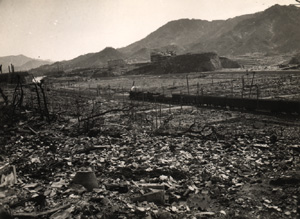 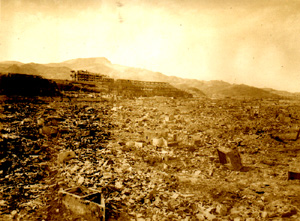 Click images to enlarge |
|
|